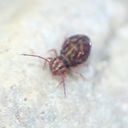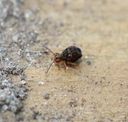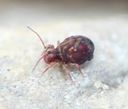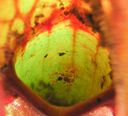Dicyrtomina
Dicyrtomina
Classification
- Phylum: Arthropoda
- Subphylum: Hexapoda
- Class: Collembola
- Order: Symphypleona
- Family: Dicyrtomidae
- Subfamily: Dicyrtominae
- Genus: Dicyrtomina
Pronunciation
How to pronounce Dicyrtomina: /ˌdaɪsɪrtəˈmaɪnə/
These audio files are automatically generated. While they are not always 100% accurate, they are a good starting point.
Images






Summary
Dicyrtomina is a genus of springtails characterized by their distinctive pale cross-shaped dorsal markings. They are found in a variety of habitats and contribute to the decomposition of organic matter.
Physical Characteristics
Distinct pale cross-shaped dorsal marking is a key identifier.
Identification Tips
Look for the pale dorsal marking when distinguishing from Ptenothrix.
Habitat
Found in leaf litter, soil, and decomposing organic matter.
Distribution
Widely distributed; exact distribution varies by species.
Diet
Feeding on decaying plant material and microorganisms.
Life Cycle
Typical springtail life cycle, involving egg, juvenile, and adult stages.
Reproduction
Reproduces sexually; may involve aggregation behaviors during mating.
Predators
Include other soil arthropods and some predatory insects.
Ecosystem Role
Plays a role in decomposition and nutrient cycling in the soil ecosystem.
Collecting Methods
- Malaise traps
- Soil samples
- Litter sifting
Preservation Methods
- Ethanol preservation
- Drying
Evolution
Part of the evolutionary lineage of hexapods with adaptations for a detritivorous lifestyle.
Similar Taxa
Misconceptions
Often confused with other genera due to similar appearance, especially Ptenothrix.
Tags
- Collembola
- Dicyrtomidae
- springtails
- soil ecology